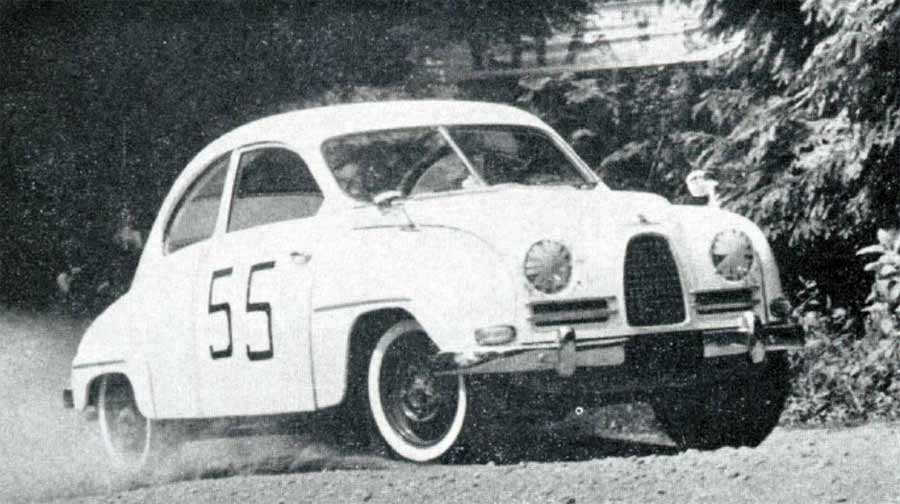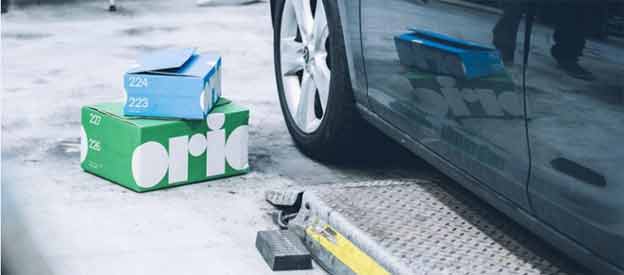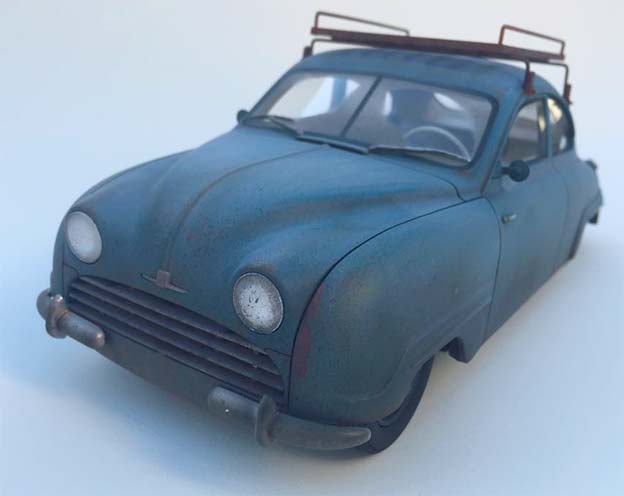One of the strangest aspects of the invasion of the North American continent by SAAB is the manner in which the sales beachhead was established. The first two SAAB 93‘s arrived in Brooklyn in the spring of 1956. The two little white car attracted little notice, but they had been landed on what might be described as a serious and vitally important mission.
Table of Contents
2 Little White SAABS
First they were used as conversation piece and demonstrators with various carefully elected dealers. Then they made their debut at the In ternational Automobile Show at New York’s Coliseum. The excitement they created was fabulous. The novel configuration of the engine and transmission and the car’s functional streamlining set people talking, Even if they shook their heads, they talked.
At that time, however, you couldn’t buy a SAAB in the United States. They were just cal’s that were being talked about whenever men talk about cars. Only a few automobile editors, writers, and selected drivers were allowed to try them out. Their enthusiastic report fanned the flashes of interest spreading across the country.
Meanwhile, the SAAB sales brain trust was considering the most sufficient way to cash in on the furor caused by the unveiling of their novel product, which had already established a reputation throughout Europe.
It might have been easy at that stage to import a few thousand SAABs and sell them like proverbial hot cakes, but SAAB was not interested in obtaining mass sales unless it could service its product. It sounds wonderful to be able to announce that you have a coast-to-coast dealer network, but multi-dealer organizations without service facilities had already proved to be the worst advertisement for some-imported marques.
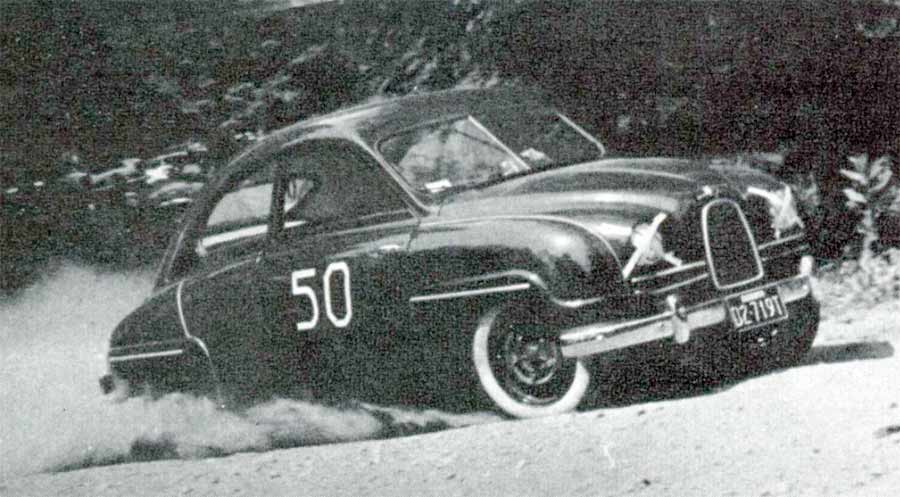
No matter how much he likes his car, once he is held up because of the lack of spare parts or service information the average American throws up his hands in despair and makes plans to trade his car in for another product. Worse still, he’s going to talk about his troubles and give the marque a bad name.
The SAAB people decided to avoid taking any such risk. They knew their product was good, and they wanted to launch it soundly, ethically, and profitably. No SAAB would ever to be sold anywhere in the U.S. where SAAB-trained service was not immediately available. That’s what decision-makers at Saab used to think, and they were absolutely right.
The North Atlantic states were selected as the trial area for sales. A depot was established at Hingham, Massachusetts, some 14 miles south of Boston. Here, the newly-arrived cars would be stored and prepared for sales. With each car came an abundant supply of spare parts, which were stored and catalogued.
Rally races were initially key to Saab’s success in the US market
Some of the new cars were used for demonstration purposes, but it was important to establish a reputation on the American scene. In November 1956, SAAB Motors, Inc., now under the direction of Ralph T. Millett – who had represented the SAAB Aircraft Company in the United States since 1947 entered a team of three stock SAABs in the Great American Mountain Rally. Under the direction of Rolf Mellde, head of SAAB’s competition department in Sweden, the venture paid off.
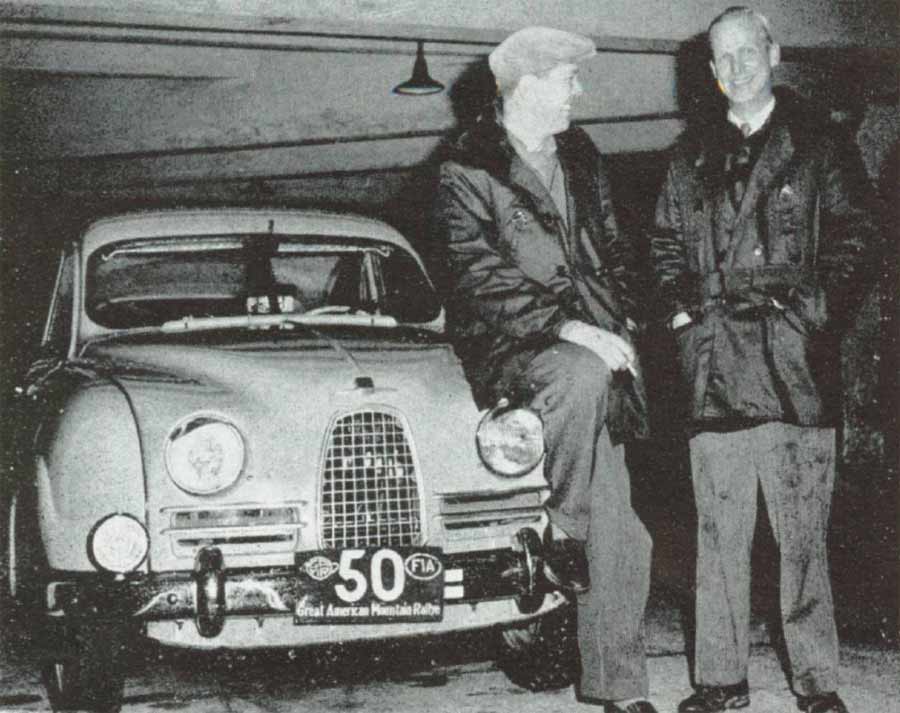
The SAAB driving team headed by Bob Wehman, after that SAAB Service Manager, partnered by Lou Braun, won the over-all, class and team awards in what was (then) undoubtedly one of the world’s toughest events, perhaps second only to the Round Australia Rail in punishment handed out to competing cars.
Launch Into Orbit
The surprising victory shot SAAB into the headlines. The little white cars became a hot subject for discussion wherever sports car fans gathered. SAAB was being talked about from coast to coast; and the most exciting and exasperating factor about the new car was that it was “rare.”
Everybody wanted a SAAB; but where were they?
A few weeks after the announcement of the SAAB’s first big victory on American soil, the Viking automobile invasion began. Two hundred and fifty SAAB 93’s were landed in Boston Harbor!
As the cars were unloaded, SAAB’s Rolf Mellde was hurriedly organizing and operating the first SAAB service school at Hingham. The men who attended it were learning how to service the car by means of the latest instructional aids, including special films and sectionalized mock-ups of the car and its unique engine.
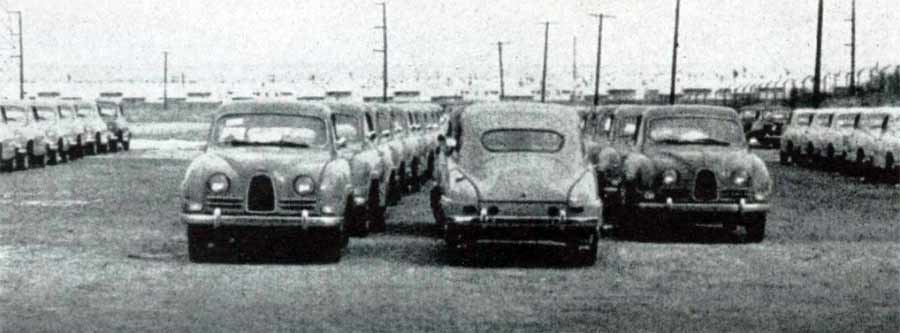
Here again the company displayed what proved to be superb merchandising generalship. Each prospective SAAB dealer had to sign an agreement stating that he would put his service personnel through the SAAB service school, and also would stock a minimum number of spare parts.
It was further decided to restrict dealership to areas where SAABs could be readily supplied with spares. At all costs, supply lines were not to be spread too thin. Those dealerships were handed out in strict proportion to the number of car that Sweden could export, and in proportion to the available spares.
Dizzying growth in Saab car sales
By the end of 1957, SAAB had some 60 dealers who sold 1,500 automobiles. Each had a backlog of orders. The SAAB was literally selling itself.
Quite naturally, the Great American Mountain Rally victory attracted widespred attention among crack American drivers. People literally stood in Iine to get SAABs. The car became a hot favorite as SAAB’s astonishing list of competition victories began to build up. Rarely has any car caused such a sensation.
By the end of 1958, SAAB dealers were among the ten top importers in relation to the sales-per-dealer factor. More than 3,500 new SAAB cars were registered in 1958, twice the 1957 total.
The increasing U.S. demand for the car was responsible for the accelerated completion of a new automobile factory in Sweden. Instead of selling 3,600 SAABs in the U.S. in 1959, the quota was raised to 5,000. Florida was invaded after a new preparation and factory depot had been set up in Jacksonville. Next, dealers were appointed in the Middle West. To ease the load at Hingham, a SAAB storage and preparation depot was opened at Cartaret, New Jersey. More spare parts were imported and stockpiled, and additional service schools put into operation.
By the end of 1959 – 40 new dealerships had been added, giving Saab a total of 160. In spite of this glittering success, the SAAB management still refused to “go national.” They remained as conservative and determined in their conception of sales promotion as in their engineering, rigidly sticking to their policy of selling only in areas where they had established supply lines.
Quality service and immediately available spare parts
Despite the arrival of the domestic compacts, the SAAB passed its U.S. sales goal of 5,000 units. At that time, SAAB has spare parts valued at over one and a half million dollars strategically stockpiled in the U.S.
The policy of the company then represented by Ralph Millet was to provide Saab car customers with quality service and immediately available spare parts (without any waiting)!
Improvements in Saab cars
SAAB dealers were largely responsible for the various improvements that have been put into the SAAB since it has been on sale in these United States. SAAB Motors president Ralph Millet regularly sends out questionnaires to his dealers asking them to report customer suggestions and complaints, and to add their own ideas for improving the product.
Since the first Saab was sold in America, no fewer than 31 improvements have been embodied in the design without extra costs to the buyer. These are listed below:
- Heater and defroster
- Key starter
- Full instrumentation
- Larger fuel tank
- Safety-padded dashboard
- Windshield washers
- Self-cancelling turn signals
- Adjustable lounge seats
- Safety sun visors
- Vinily upholdery
- Foam rubber upholdery
- Undercoating
- Safety belt fittings
- Safety glass all around
- More powerful engine
- Wrap-arounf rear windows
- Wider 3-passanger back seat
- Air circulations vents
- Opening side rear windows
- Double size locking glove compartment
- Larger radiator
- Larger brakes
- Theft-proofing ignition lock
- Double acting shock absorbers
- Front arm rest
- Adjustable rear seats
- Dome light
- Front hinged doors
- Larger air scoop
- Improved door locks
- 23% more luggage space
It is interesting to note that Sweden maintains an ideal balance of import-exports with the U.S. SAAB, for instance, imports a considerable amount of aircraft and electronic components and pays for them in cash, and SAAB dealers in Sweden import and distribute Chryster Corp. automobiles and parts. This results in a healthy and harmonious international commerce, entirely devoid of any menace to either nation’s industrial economy or currency.

